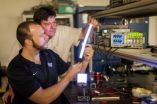Surprising results from study of non-epileptic seizures
2012-12-03
(Press-News.org) MAYWOOD, Il. - A Loyola University Medical Center neurologist is reporting surprising results of a study of patients who experience both epileptic and non-epileptic seizures.
Non-epileptic seizures resemble epileptic seizures, but are not accompanied by abnormal electrical discharges. Rather, these seizures are believed to be brought on by psychological stresses.
Dr. Diane Thomas reported that 15.7 percent of hospital patients who experienced non-epileptic seizures also had epileptic seizures during the same hospital stay. Previous studies found the percentage of such patients experiencing both types of seizures was less than 10 percent.
Thomas reported the findings Dec. 2 at a meeting of the American Epilepsy Society.
The finding is significant because epileptic and non-epileptic seizures are treated differently. Non-epileptic seizures do not respond to epilepsy medications, and typically are treated with psychotherapy, anti-depressants, or both, Thomas said.
Non-epileptic seizures used to be called pseudoseizures. But they are quite real, and the preferred term now is psychogenic non-epileptic seizure. A non-epileptic seizure can resemble the convulsions characteristic of a grand mal epileptic seizure, or the staring-into-space characteristic of a petit mal epileptic seizure. But unlike an epileptic seizure, the brain waves during a non-epileptic seizure are normal.
Non-epileptic seizures can be triggered by stresses such as physical or sexual abuse, incest, job loss, divorce or death of a loved one. In some cases, the traumatic event may be blocked from the patient's conscious memory.
Non-epileptic seizures often are mistaken for epileptic seizures. While some patients who have both types can distinguish between the two, others find it difficult to distinguish when they are having non-epileptic seizures.
The only way to make a definitive seizure diagnosis is to monitor a patient with an electroencephalogram (EEG) and a video camera. (The EEG can detect abnormal electrical discharges that indicate an epileptic seizure.) The patient is monitored with the camera until a seizure occurs, and the EEG recordings from the event are then analyzed.
Thomas conducted her study at the University of Maryland Medical Center, where she did a fellowship in epilepsy before recently joining Loyola. Thomas and colleagues reviewed 256 patients who had come to the hospital to have their seizures monitored. Seventy of the patients had documented non-epileptic seizures. Of these, 11 patients (15.7 percent) also experienced epileptic seizures during their hospital stays.
INFORMATION:
Thomas is an assistant professor in the Department of Neurology of Loyola University Chicago Stritch School of Medicine. In addition to epilepsy, her special interests include HIV neurology.
ELSE PRESS RELEASES FROM THIS DATE:
2012-12-03
Bulk solvents, widely used in the chemical industry, pose a serious threat to human health and the environment. As a result, there is growing interest in avoiding their use by relying on "mechanochemistry" – an energy-efficient alternative that uses high-frequency milling to drive reactions. Because milling involves the intense impact of steel balls in rapidly moving jars, however, the underlying chemistry is difficult to observe.
Now, for the first time, scientists have studied a milling reaction in real time, using highly penetrating X-rays to observe the surprisingly ...
2012-12-03
A tiny, translucent zebrafish that glows green when its liver makes glucose has helped an international team of researchers identify a compound that regulates whole-body metabolism and appears to protect obese mice from signs of metabolic disorders.
Led by scientists at the University of California, San Francisco (UCSF), the work demonstrates how a fish smaller than a grain of rice can help screen for drugs to help control obesity, type 2 diabetes and other metabolic disorders, which affect a rising 34 percent of American adults and are major risk factors for cardiovascular ...
2012-12-03
STANFORD, Calif. — The surface of your skin, called the epidermis, is a complex mixture of many different cell types — each with a very specific job. The production, or differentiation, of such a sophisticated tissue requires an immense amount of coordination at the cellular level, and glitches in the process can have disastrous consequences. Now, researchers at the Stanford University School of Medicine have identified a master regulator of this differentiation process.
"Disorders of epidermal differentiation, from skin cancer to eczema, will affect roughly one-half ...
2012-12-03
STANFORD, Calif. — Fifteen new genetic regions associated with coronary artery disease have been identified by a large, international consortium of scientists — including researchers at the Stanford University School of Medicine — taking a significant step forward in understanding the root causes of this deadly disease. The new research brings the total number of validated genetic links with heart disease discovered through genome-wide association studies to 46.
Coronary artery disease is the process by which plaque builds up in the wall of heart vessels, eventually leading ...
2012-12-03
Say goodbye to that annoying buzz created by overhead fluorescent light bulbs in your office. Scientists at Wake Forest University have developed a flicker-free, shatterproof alternative for large-scale lighting.
The lighting, based on field-induced polymer electroluminescent (FIPEL) technology, also gives off soft, white light – not the yellowish glint from fluorescents or bluish tinge from LEDs.
"People often complain that fluorescent lights bother their eyes, and the hum from the fluorescent tubes irritates anyone sitting at a desk underneath them," said David Carroll, ...
2012-12-03
A new study suggests that the common diabetes medication metformin may be considered for use in the prevention or treatment of ovarian cancer. Published early online in CANCER, a peer-reviewed journal of the American Cancer Society, the study found that ovarian cancer patients who took the drug tended to live longer than patients who did not take it.
New treatments are desperately needed for ovarian cancer. Previous research has indicated that metformin, which originates from the French Lilac plant, may have anticancer properties. To look for an effect of the medication ...
2012-12-03
ARLINGTON HEIGHTS, Ill. (December 3, 2012) – Food allergies are on the rise, affecting 15 million Americans. And according to a new study published in the December issue of Annals of Allergy, Asthma and Immunology, the scientific journal of the American College of Allergy, Asthma and Immunology (ACAAI), pesticides and tap water could be partially to blame.
The study reported that high levels of dichlorophenols, a chemical used in pesticides and to chlorinate water, when found in the human body, are associated with food allergies.
"Our research shows that high levels ...
2012-12-03
ROCHESTER, Minn. -- Diabetic patients with ovarian cancer who took the drug metformin for their diabetes had a better survival rate than patients who did not take it, a study headed by Mayo Clinic shows. The findings, published early online in the journal Cancer, may play an important role for researchers as they study the use of existing medications to treat different or new diseases.
Metformin is a widely prescribed drug to treat diabetes, and previous research by others has shown its promise for other cancers. The Mayo-led study adds ovarian cancer to the list.
Researchers ...
2012-12-03
WASHINGTON – For people living in both rich and poor countries, the average person's happiness is based on a combination of individual wealth, possessions and optimism, according to an analysis of new worldwide survey findings published by the American Psychological Association.
A country's gross domestic product per capita did not have as much of an impact on the average person's happiness, according to research based on responses of 806,526 people in 135 countries from 2005 to 2011. Happiness expert and psychologist Edward Diener, PhD, of the University of Illinois, ...
2012-12-03
Public relations and social media expert Joyce Luhrs will provide free one-on-one consulting about public relations and publicity to nonprofit leaders attending the Center for Non-Profits' annual conference, Riding the Winds of Change: Harnessing Our Collective Power. Nonprofit leaders and executive directors of organizations throughout New Jersey will participate in the daylong event on Wednesday, December 5, 2012 at the Crowne Plaza Monroe in Jamesburg, New Jersey.
A public relations, marketing and grants consultant with over 20 years experience, Ms. Luhrs is volunteering ...
LAST 30 PRESS RELEASES:
[Press-News.org] Surprising results from study of non-epileptic seizures


